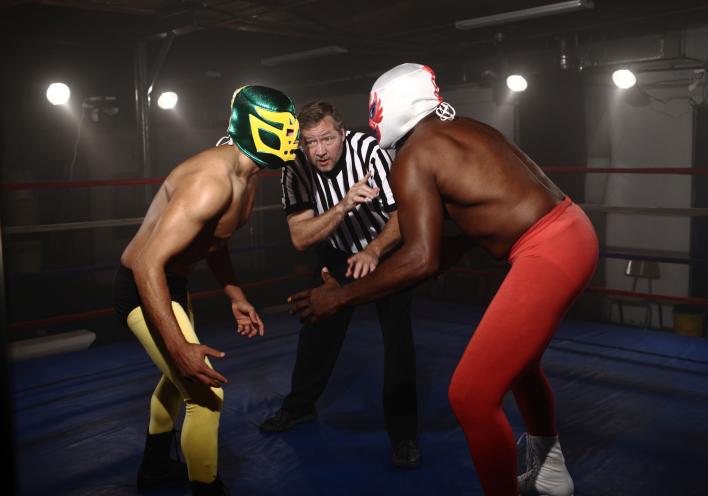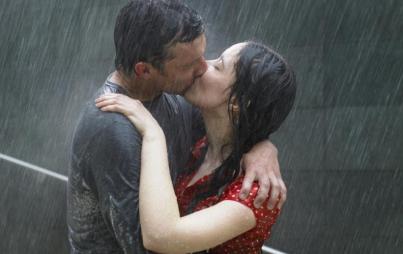
Credit: Thinkstock
Wrestling is a medium of real-time storytelling. A wrestler's "finisher"—the special, trademark move that unravels these sucker-punch pantomimes—embodies their voice and lets free the lingering tension of audience suspense. Verily, a match undone by the odd shoulder block or hip toss might be more "true to life," but in true life a bar-scuffle is comprised of five minutes of screaming and posturing and about 9 seconds of actual fighting.
If you rolled into Tupelo, Mississippi with two hours worth of that on-edge enticement without regulated release, you'd leave behind an arena full of listless pod people. This is (part of) why people riot after sporting events. When THE GAME CAN CHANGE AT ANY MINUTE AND THEN IT DOES, OFTEN WITHOUT DUE DRAMATIC BUILDUP, there's no closure. You're just juiced, on auto-pilot, and without distraction.
Wrestling conserves crowd emotion through empathy—I could probably take a couple body slams, but I have seen a fair share of people stronger and more fit than me freefall into defeat from Bryan Danielson's Cattle Mutilation. This fight is over. As it should be, as it would be—if that were me.
After a fight, I have closure—at least until I get on the bus and read the litany of livetweets about the event and frantically cobble contextually appropriate reaction gifs and memes highlighting my pleasure and/or distaste with various wrestlers. As a faceless hive of harassment looms over video games and my friends are forced from their homes and field tweets from parody accounts mocking their terminally ill pets, it is a comfort to be reminded that there is a community of people devoted to the curation of debate on whether this spray tanned playfighter was a better spray-tanned fighter than this other spray-tanned play fighter who is definitely the bad guy because he's from somewhere else—and that I could crush their wack and wayward wax-and-waning with a flourish of feminist dialectic.
You best stay out in the popcorn stand, where it's warm and smells vaguely of the happy summer afternoons you spent with your father at the county fair. You come into this theoretical ring and you will be worked over with overwrought analysis of a thing you have loved without critical retrospection. Your relationship to wrestling will leave this arena in pieces—pieces of a puzzle to a greater understanding of American media which you just aren't adequately equipped to decipher. Punk.
Oh, you gonna come in and whet your horns, junebug? Well I hope you have Little House on the Prairie properly queued on your Netflix-streaming device, because you're gonna need a whole lotta self-care when I'm done with you, little peach.
Feminist Interpretations of Five Pro Wrestler's Finishers
1. Go 2 Sleep (Knee to the chest from a fireman's carry)
KENTA
As a queer transgender woman currently perusing sterilizing measures, I am not afforded many opportunities to scream "GO TO SLEEP!" at the top of my lungs at another human, child or otherwise—there is a certain solace in the war cry that follows KENTA's kinetic coup de grace. With a fell swoop—of his knee into the center of another man's chest, rendering the air in his lungs and the visual stimuli in his eyes effectivey expatriated—KENTA has in a sense queered the wrestling finisher. It's a very inclusive malice.
And perhaps even the most self-critical: by placing him up on his shoulders and tossing him into the air, KENTA elevates his hypermasculine rival and then quickly and efficiently eschews him and the culture that man represents by hitting him where it hurts, his heart. What is in the heart of a man? Well after KENTA drops you on his knee like fourth period chemistry, you may not have a heart anymore—are you still a man? Is KENTA putting you—or the toxic masculine culture that spawned you—to sleep? And does his ablility to make manifest this maneuver from any position (standing, mid-grapple, mid-air) a commentary on the ubiquity of that same toxic masculinity, and how we must always be on guard?
Sleep aid abuse is apparently a pressing issue in Japanese wrestling: Bryan Danielson alone appears in this compliation four times. Maybe this reactionary fever pitch of MRA and PUA violence we're seeing through social media are the symptoms of masculinity's insomnia? You've had all the privilege for a long time, now bud. Maybe you just need a nap. Yeah. Let's grab your Wrestling Buddy and go lie down. Yes, we can watch a barbed wire cage match while you get tucked in.
2. Canadian Destroyer (Front flip piledriver)
Petey Williams
A quick litmus test: is WWE owner Vince McMahon unafraid to make public speaking engagements? Then MRAs aren't about men. Wrestling promoters like McMahon's storied obsession with bulk and mass has upended countless men's lives and careers. Do you start taking steroids or do you stick to high school gymnasiums and church picnics? That's the 30-year-or-more question that's hung over the heads of many trying to build a career and support a family. Steroid abuse is traumatic; men take them because they work in industries that require their use, even if it's "on the books discouraged," just to keep up with demand. That's men imposing impossible body standards onto other men. All these words you think women made up are real experiences that are happening to men every fucking day.
You don't need masculinism. You need to learn how work and start caring about actual men who are experiencing actual gendered violence.
William's front flip piledriver requires the opponent be as tall or taller than him—no small feat in that he's one of the shortest male wrestlers in the business (not including "minis"). The master's tools can never dismantle the master's house: Petey is billed at 5'7" 179 pounds, easily six inches shorter and 70-80 pounds lighter than "main event" wrestlers like legends Triple H, The Rock, or Hulk Hogan (who was consistently billed at 303 pounds). He could have tried bulking up to better meet the "size requirements" of the industry, but doing so would have cost him what made him unique and dynamic—this clip was shown to my colleague Giana, who knows nothing about wrestling, and it emitted quite the gasp of excitation from her. That is a grace and physicality that transcends "fandom" and will last longer than all of our charts and sheets about who won how many titles.
You can try to play "their game"—bringing this back to real life—and you can learn their systems and their language, and there is no shame in that. Surely, a fluency in your opposition is necessary for liberation. But prison abolition will not be ended by us all becoming prison guards. We will only end up with a slightly more stylish correctional system.
3. Widow's Peak (Modified standing neckbreaker)
Victoria
Close that fucking email window: this isn't a typo. Most women wrestlers today perform under a single name, unless a righteous alliteration is to be reaped (A.J. Lee, Molly Holly, etc). This infantalizes women performers and keeps them tied to their employer. When Bryan Danielson got the job with WWE, he was given a list of possible names that he could wrestle under. His real name, the one he wrestles under, was not one of them. So he know wrestles as Daniel Bryan. WWE did not want him wrestling under a name they could not own. By giving women half a moniker to perform under, they assert ownership over the fractured remnant of an identity they allow these women to have.
Victoria once used t.A.T.u's "All The Things She Said" as her entrance theme—a hostile, almost predatory intimacy with other women is permeated in her wrestling style and identity. KENTA throws his opponents in the air, Petey puts their head between his legs; Victoria cradles her opponent's face to hers, almost like a mother, before dropping them into a whiplash blackout. It's a ripped right from Lavender Scare-era films like All About Eve and The Children's Hour, the scheming semi-villainess, semi-paramour.
Like Trish Stratus' Stratusfaction and Michelle McCool's Faithbreaker, Victoria's finisher has an almost aggressive margin for hurting herself and her opponent, a fearless and practiced rebuttal against the industry's antipathy to women wrestlers—and at no small cost to the performers. Larger, more established wrestlers have coasted on half nelson slams and spears—moves so fundamental that I was able to teach them to lube wrestlers who've never lifted weights or done situps outside of P.E.
To be a women's wrestler, to go beyond the purgatory of "bra and panties matches," you must not only defy expectations, you must cradle and then immediately drop them on their stupid face.
Or, to be more specific, on the nerves and airway of the neck that regulate consciousness.
4. Mandible Claw (????)
Mick Foley as Mankind, Dude Love, and/or Cactus Jack
Though my heart belongs to Mayumi Ozaki, Mick Foley is the wrestler who kept me in wrestling long enough to discover Japanese women's wrestling, and in turn engage with my womanhood through emphatic physicality.
Foley is a children's author, abuse survivor's advocate and LGBT ally. Derided a "glorified stuntman" for his hardcore wrestling style and notoriety in "taking bumps" (very painful and demanding stunts such as falling off the roof off a cage onto an arena floor), Foley embodied a gentle resistance to the toxic masculinity of wrestling. Even at the height of his career, his figure could only be described as "blobby, kinda slouchy." He didn't call his opponents fags, he didn't fall into an orgasmic trance when attacking women—he was a sensitive guy with a beard who wrote books about Christmas while he recovered from concussions and barbed wire punctures.
It is hard to retire from wrestling. The skills you acquire—spending a decade on tour, learning how to use a rotation of different prescription painkillers to manage your ever-present soreness without becoming addicted and failing a wellness test—do not "translate well" to other industries. This is often why you find wrestlers still in their 50s, hobbling around the ring in search of droplets of crowd approval, or charging money for autographs at comic conventions.
Get on this, men's rights activists. Sports are not sustainible for men.
Mick Foley keeps coming back to wrestling. You can see it in his limp and the way he talks that he needs, for his health, for his family's health, to be far and away from even the fascimile of a wrestling ring. But wrestling in a sense needs Mick Foley, even if he isn't competiting in the ring—his absence would suggest there is room for future slouchy "average guys" in wrestling. You and I must never believe that we, yes even we, could become wrestlers. It must remain elite, prestigious, and shrouded in mystery, free from the regulation of athletic commissions. Or else you couldn't charge people $60 to watch three hours of men punching each other in the balls.
But jesus—Mick's finisher is a little, let's leave it at invasive? Forcibly shoving your fingers in the throat of another wrestler seems counter to the mission of RAINN. It leaves one to wonder if the activism is an atonement for having a finisher that actually mirrors sexual abuse. Which would be fine—BUT YOU HAVE TO STOP DOING IT ONCE YOU BECOME A SPOKESPERSON FOR RAINN, MICK.
THAT'S HOW GUILT WORKS.
5. Atomic Leg Drop/Leg Drop of Doom (Running leg drop)
Hulk Hogan
Hulk Hogan's status as the quintessential "good guy" of wrestling says a lot about us as Americans, and none of it is any good. If you write off his bullying of talk show hosts and blackmailing of Vince McMahon to get title shots as "out of character," there's still the racism (calling Yokozuna "the Jap"), beating up disabled people (Andre the Giant endured acromelagy and was clearly barely holding himself up during their classic WrestleMania 3 bout) and slavish devotion to the pursuit of world titles that has turned every one of his on-screen friends into resentful rivals. To say Hulk Hogan represents the All-American ethos is to say that we understand and accept ourselves as petty materialists.
But it would be an illuminating illustration of white privilege. The man who arguably made pro wrestling into a pop culture monster, who has set the standard of physicality for four decades of performers, and his finishing hold is the equivalent of "oh I meant to do that." His piece de resistance is a basic 101 wrestling move taught early on because even if you did it to someone on puprpose, it wouldn't actually hurt them—and we've allowed this for longer than some of us have been alive. For us, the image and concept of Hulk Hogan, the blonde American ubermensch who destroys foreign threats with the power of rock and roll, is of more importance than his actual substance.
We are thus, in poker parlance, pot committed: If we accept that Hulk Hogan's matches are largely slow, plodding forays and that his entire career has been a ghost hype train and that by elevating him, we have created a demand for his brand of mediocrity, however much we have come to disdain it, then we may have to reconsider all of the last 40 years of wrestling history and how we may have bungled the whole thing by backing the wrong horses and creating an environment where size and political posturing trump over sustainability and actual performance of quality.
And man: do we as white 20-30 mostly males have a history of not coping so great with that.
But Yokozuna was Samoan. Samoan.





![By Magicland9 [CC BY-SA 3.0 (https://creativecommons.org/licenses/by-sa/3.0)], from Wikimedia Commons By Magicland9 [CC BY-SA 3.0 (https://creativecommons.org/licenses/by-sa/3.0)], from Wikimedia Commons](/sites/default/files/styles/profile/public/images/article/2019-06/Bell.png?itok=gWp6s_Y0)
